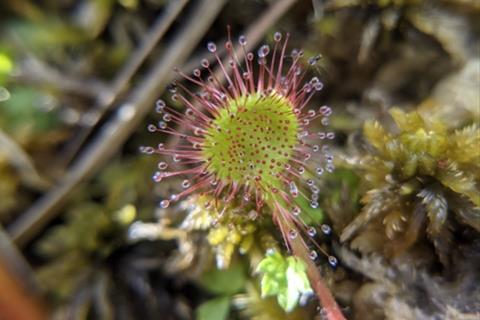A new study has uncovered a symbiotic relationship that has evolved between Darwin’s favourite carnivorous plant and a specific type of fungus which lives inside it and helps it digest its prey.

Researchers from Loughborough, Taiwan and USA have shown that Acrodontium crateriforme, a fungus that thrives in the acidic conditions on the leaves, improves the digestion of the Drosera species of carnivorous plant – otherwise known as a sundew (pictured above), and once described by Charles Darwin as, “a wonderful plant… I care more about Drosera than the origin of all the species.”
READ MORE: Promoting plant growth with the help of yeasts
READ MORE: The hidden symbiosis between blueberries and ericoid mycorrhizal fungus
The fungus lives in a sticky secretion at the end of tentacles on the leaves. Its enzymes work with the plant’s own digestive processes to help it break down the prey – small bugs and insects.
Prey digestion
In a new paper, published in Nature Microbiology, the lab group in Academia Sinica in Taiwan studied what happens during prey digestion when the plant is digesting prey alone versus when the plant and fungus are both together, this demonstrated that when fungus and plant grow together prey digestion is faster than when the plant is trying to digest the prey by itself.
Brandon Shaw and Dr Jonathan Millett of Loughborough School of Social Sciences and Humanities, showed that Acrodontium crateriforme is present in at least four species of carnivorous Drosera species across three continents.
“Our data showed that A. crateriforme is present and often dominant in several other Drosera species growing in Taiwan and both the UK and the US,” said Brandon.
Co-evolution of symbiosis
“The fact that this fungus is present in different plants in different locations provides strong evidence that this symbiosis has co-evolved and has been important in driving adaptations to plants being carnivorous.”
“This work transforms our understanding of how carnivorous plants work, but also demonstrates that for some carnivorous plants, this symbiotic relationship with a fungi is a core part of carnivory.
”I think that exploring just how ancient and widespread this symbiosis is will offer important insights - sampling from across the Drosera phylogeny to see which lineages have evolved with this symbiont. Possibly they all have!”
Plant carnivory
Dr Millet added: “The evolution of carnivorous plants has fascinated scientists right back to Darwin, who wrote a book about them, however, the role of fungal symbionts in the evolution and function of carnivorous plants has been overlooked, which is why this study is significant.”
“This study provides the first extensive picture in the role of a fungus in plant carnivory and therefore alters our idea of how this unique adaptation may evolve i.e. collaboration between plants and fungi may help to drive plant evolution.”
The project was funded by UKRI through NERC. The study was led by Isheng Jason Tsai and his PhD student Pei-Feng Sun.
Brandon’s contributions to the study were funded by Central England NERC Training Alliance (CENTA) PhD studentship (NE/S007350/1) and the UK NERC Environmental Omics Facility (NEOF; NEOF1465).
Topics
- Acrodontium crateriforme
- Applied Microbiology International
- Asia & Oceania
- Brandon Shaw
- carnivorous plants
- community
- digestive enzymes
- Drosera
- Ecology & Evolution
- Fungi
- Healthy Land
- Jonathan Millett
- Loughborough School of Social Sciences and Humanities
- Research News
- Soil & Plant Science
- symbiosis
- UK & Rest of Europe
- USA & Canada







No comments yet